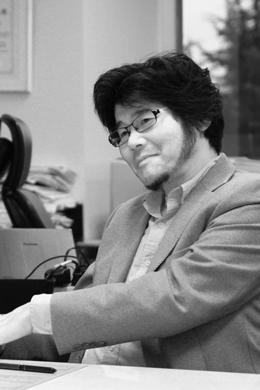An Application-Driven Search for New Materials
Shigeo Maruyama / Professor, The University of Tokyo, Graduate School of Engineering

Q: How did you get into carbon nanotube research?
Maruyama: I started out in a completely different field, conducting doctoral research on turbulent heat transfer in mechanical engineering. Even at that time, however, I was of a mind to try something new; and it so happened that I ended up studying abroad at Rice University, home to Richard Erret Smalley, winner of a Nobel Prize in 1996 for their discovery of fullerenes. Although I had no particular awareness of fullerenes, when I returned to Japan in 1991 after a two-year stint at Rice, it was right at the time when it became possible to synthesize fullerenes in macro quantities in the laboratory, so I decided to give it a try.
Q: Why did you choose to focus on single-walled rather than multi-walled nanotubes?
Maruyama: Multi-walled have their own appeal from the standpoints of thermal and other dynamics, but what I find really interesting is that single-walled nanotubes can become semiconductors. When carbon fiber is made very thin resulting in a semiconducting nanotube, it is not just a metal, or even the ultimate metal, but something that seems to turn the world upside down. This is the fascinating thing about single-walled nanotubes that makes me intent on studying them.
Q: On the one hand there’s the scientist’s spirit of pursuing the interesting, and on the other the engineering aspect of looking for practical applications. Do you have a problem reconciling these seemingly opposite poles?
Maruyama: I think both of these are in pretty good balance, so no, it’s not really a problem for me. After all, engineering has long been my field, including my doctorate. Someone in engineering will eventually come to think about practical uses, so even if we run off in the direction of pursing our fascinations, at the same time we have in the back of our mind the thought that at some point we will start considering methods of application. The notion of wanting to make use of something basic to do something practical is quite natural, I feel. It’s the opposite that is hard. It is actually difficult for someone who reaches a certain age after thinking only about applications to suddenly turn their attention to physics and science. Along with your interests, you also have to study the basics. The basics are the hard part.
Q:You devised an alcohol chemical vapor deposition technique to synthesize carbon nanotubes. The applications for this appear to have been narrowed down lately to energy uses. How did this come about?
Maruyama: If anything, my original fascination has been with materials. The mechanical engineering classes I teach, however, are about energy, so that has become my mission. Another reason is that many of my senior colleagues in the laboratory are in the energy field, and in the course of working with them the topic of current application needs arises. In the field of energy or solar cells, when someone says, “Isn’t this an interesting property?” it’s only natural to want to give it a try. Also, given my age, I have less than 10 years left to work as a researcher, so that might be another reason for narrowing down the applications.
Q: When you say you have less than 10 years left as a researcher, are you back-calculating?
Maruyama: Yes. Up to now I’ve been allowed to do whatever I like, so now I feel I need to come up with something concrete. In that sense, I believe engineering has to lead to something relevant to things, to a certain extent at least. It’s a bit different from science in that way. Of course, if a time comes in the future when something new can be created, it might be OK to abandon that ideal. Still, I’ve come this far with carbon, which is so much a part of me that it would be hard at this point to give it up. From the standpoint of applications, though, there’s no guarantee that this will turn out to be the best approach; so looking at the applications aspect could lead us in an entirely different direction.
Q: Finally, I’d like to ask you to say a few words to the students in the GSDM program or thinking about entering it.
Maruyama: I can’t avoid paying most attention to science students. As research proceeds, there will inevitably be relevance to applications and to society; and here there are things that need to be learned. In that sense, I believe today’s students are really good at communication. My first time in the US was spent at Professor Smalley’s lab. The language barrier and cultural differences made things tough. In that regard, today’s GSDM students will be sent abroad even if they themselves don’t have that intention, so I believe they are blessed with a wonderful environment. Even so, it is up to the students themselves to discover something of interest in that environment. Too much of a good thing is likely to make them feel overwhelmed, and I suppose students may find themselves challenged. In any case, I definitely would like GSDM students to make the most of the opportunities and the environment to pursue their studies. My hope is that they will try various things and do what they are capable of doing.
